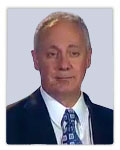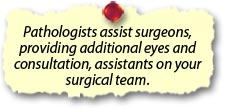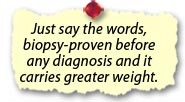|
|
 Steve McClain, MD
Steve McClain, MD
|
Funny thing about the truth, it cannot be hidden. More than once, my Grand Dad said to me, “Measure Twice and Cut Once”, and eventually the lesson stuck. This close to earth, gravity always wins. Likewise, the truth always wins. But just how does Pathology practice or any of its components, formalin, chemical stains, molds growing, and laboratory technicians slouched over microscopes or microtomes, make you a more successful surgeon?
 My short answer is - because Surgical Pathologists are also Surgeons.. Okay, my own surgical skills fail to measure up to lowly barber surgeons, much less those of the several fine podiatric surgeons with whom I practice. Yet I maintain pathologists are surgeons nonetheless. Mostly we assist surgeons, providing additional eyes and consultation, assistants on your surgical team. You take care of cutting and repairing and dressing and offloading; we do the analysis, measuring, microscopy and photography, and other lab stuff as needed. In any one case, my power augments your power, and even more so when you call on us.
My short answer is - because Surgical Pathologists are also Surgeons.. Okay, my own surgical skills fail to measure up to lowly barber surgeons, much less those of the several fine podiatric surgeons with whom I practice. Yet I maintain pathologists are surgeons nonetheless. Mostly we assist surgeons, providing additional eyes and consultation, assistants on your surgical team. You take care of cutting and repairing and dressing and offloading; we do the analysis, measuring, microscopy and photography, and other lab stuff as needed. In any one case, my power augments your power, and even more so when you call on us.
Surgical pathology, my field, is rooted in surgery. It was founded by the surgeon who set modern surgery on its present course; a defining moment where surgeons saw the benefits to pathologic study for all tissues removed at surgery. The first textbook in surgical pathology, General Surgical Pathology and Therapeutics, was written by that surgeon, Theodor Billroth. Billroth rigorously trained complete surgeons, with both medical and pathology skills. That is, one person trained in all three areas as opposed to the modern segmented approach of three persons each with their own specialization. In the 150 years since Billroth, all surgical residents have been expected to know and understand microscopic diagnosis and margins of all tissues removed during their surgeries.
The 20x clarity of Billroth’s 1860s vision came from integrating knowledge of his patient’s disease on several zoom levels, surgically, clinically and microscopically (Billroth’s surgical career and ascent began just before ether made complicated surgeries possible, and some 40 years prior to the invention of radiology.). When surgeon’s and pathologist’s brains integrate visual information from two or more disparate sources, we form a mental 3-D model, having a shape and margins and host response. The shape of the cancer growth and especially its invasiveness indicates past behavior and potential, two properties which can be discerned microscopically. That Billroth came to be the leading surgeon in his era and was the first surgeon to routinely study all his cases microscopically was no accident. Integrating three observations: surgical, clinical and pathology, into a unified picture model made his surgical decision-making and actions unassailable.
Consider surgical oncology, a cancer treatment based on the notion of complete surgical excision of cancer prior to metastasis. In patient one, cancer extending to margins requires more treatment. The surgeon, seeing microscopic cancer at the medial edge, creates a map or visual image model, not only of the cancer itself, but where and how much cancer intersects with that margin. Experienced brains also imagine or predict a shape of cancer remaining in the patient and how and where to excise it. Experienced pathologically-based surgeons know in a few nanoseconds. But common sense tells you, the surgeon, who sees the cancer and treats that cancer remaining at the medial edge, is far more successful than one who fails to look.
Complete excision or debriding of all abnormal tissue also defines good ulcer wound care and heals more ulcers.
Decide today.
 Decisive, confident, successful and experience are all qualities in surgeons that engender patient trust. Decisiveness comes with second observation, while experience is a priori knowledge, acquired from previously having decided both correctly and incorrectly. When decisions are made, practice methods using more than one observation produce fewer errors in medicine. Surgical confidence accrues with the power of pathology behind you, secure in knowledge right down to the micron level. Just say the words, biopsy-proven, before any diagnosis and it carries greater weight.
Decisive, confident, successful and experience are all qualities in surgeons that engender patient trust. Decisiveness comes with second observation, while experience is a priori knowledge, acquired from previously having decided both correctly and incorrectly. When decisions are made, practice methods using more than one observation produce fewer errors in medicine. Surgical confidence accrues with the power of pathology behind you, secure in knowledge right down to the micron level. Just say the words, biopsy-proven, before any diagnosis and it carries greater weight.
Transparent fungal hyphae with outer layer stained darkly by Gentian Violet 100x.
Stain binding paralyzes fungal metabolism, the basis for the long known, but little
studied antifungal properties of GV. |
|
|
McClain Laboratories, LLC is an anatomic pathology laboratory located in Smithtown, New York. We specialize in evaluation of tissue biopsies, with an expertise in skin, nail, and oral pathology for healthcare professionals nationwide.
Gross and microscopic evaluations of specimens done at our laboratory feature:
- Color images on all reports
- Personalized imaging for research
- Review of prior biopsies
- Rapid turnaround time
- Specimen courier service
- Histology grant and research work
- Expert medical testimony
|
|
To learn more about McClain Laboratories and its products and services,
visit mcclainlab.com or call at (631) 361-4000. |